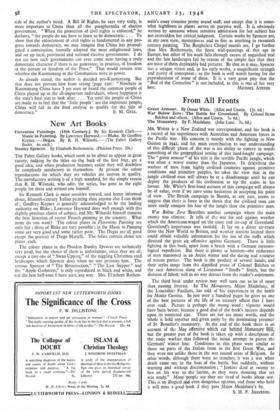From All Fronts
Green Armour. By Osmar White. (Allen and Unwin. 12s. 6d.) The Monastery. By F. Majdalany. (John Lane. 7s. 6d.)
MR. WHrrE is a New Zealand war correspondent, and his book is a record of his experiences with Australian and American forces in the Pacific war. His concern is mainly with the fighting in New Guinea in 1942, and his main contribution to our understanding of this difficult phase of the war is his ability to convey in words something of the geokraphical setting of this hard-fought campaign. The "green armour" of his title is the terrible Pacific jungle, which was often a worse enemy than the Japanese. In describing the warfare of men from highly civilised countries against primitive conditions and primitive peoples, he takes the view that in the jungle civilised man will always be at a disadvantage until he can deploy the products of his civilisation to tip the scales in his favour. Mr. White's first-hand account of this campaign will always be of value, even if we have some hesitation in accepting his point of view. The British campaign in Burma, at any rate, seems to suggest that there is force in the thesis that the civilised man can More easily conquer his fear of the jungle than the primitive man.
War Below Zero escribes another campaign where the main enemy was climate. It tells of the war for and against weather which the Americartrovaged on the coast and ice-cap of Greenland. Greenland's importance was twofold. It lay on a direct air-route from the New World to Britain, and weather stations located there could obtain valuable information for the use of the staffs which directed the great air offensive against Germany. There is little fighting in this book, apart from a brush with a German meteoro- logical expedition. But there is plenty oi heroism—the endurance of men marooned in an Arctic winter and the daring and resource of rescue parties. The book is the product of several hands, and their styles range from the dignified prose of Colonel Balchen to the racy American slang of Lieutenant " Snuffy " Smith, but the division of labour will in no way detract from the reader's enjoyment.
The third book under review may well turn out to be of more than passing interest. In The Monastery, Major Majdalany, of the Lancashire Fusiliers, has told of his experiences in the battle for Monte Cassino. In just over a hundred pages he gives us one of the best pictures of the life of an infantry officer that I have ever read. Picture- is perhaps the wrong word ; vignette would have been better, because a good deal of the book's success depends upon its restricted size. There are not too many words, and the whole is held together and given unity by the dominating presence of St. Benedict's monastery. At the end of the book there is an account of the May offensive which cut behind Monastery Hill, but the greater part of the book is taken up with a description of the static warfare that followed the initial attempt to pierce the Germans' winter line. Conditions in this phase were similar to those on parts of the Italian front in the first Great War, and they were not unlike 'those in the wet coastal areas of Belgium. In other words, although there were no trenches, it was a war when death came not in the heat of the battle, but suddenly, without warning and without discrimination ; "Jenkins died at twenty to five on his way to the- latrine, as they were shouting that tea was ready." Many 'people say they are tiled of books about war. This is an illogical apd even dangerous opinion' and those who hold it will miss a good-book if they pass Major Majdalany's by.
S. H. F. JOHNSTON.






























 Previous page
Previous page